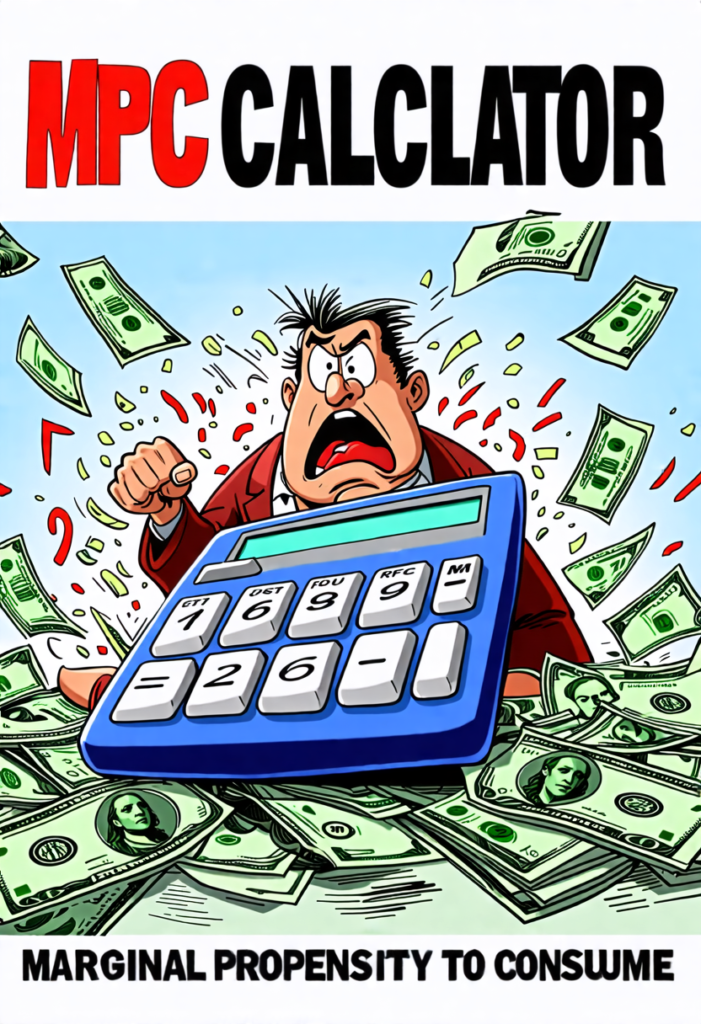MPC Calculator (Marginal Propensity to Consume)
Marginal propensity to consume (MPC) is the percentage of a raise spent on goods and services rather than saved.
Marginal propensity to consume is the ratio of household spending to disposable income. Zero to one is typical. Spending and income are unrelated at zero MPC.
When an MPC exceeds one, income levels affect consumption proportionately more.
This MPC calculator helps you calculate your MPC value easily. You need to enter the data correctly.
Just enter the increase in disposable income ($), increase in consumer spending ($), autonomous consumer spending ($), disposable income ($), and consumer spending ($).

You might want to discover the car price or cash-on-cash value.
What is Marginal Propensity to Consume?
Marginal Propensity to Consume (MPC) is an economic metric that measures the proportion of an increase in income that a consumer spends on goods and services, rather than saving. In simpler terms, it tells us how much of each additional dollar of income a person is likely to spend.
The MPC Formula
The formula for calculating MPC is straightforward:
MPC = Change in Consumption / Change in Income
For example, if a person’s income increases by $1000 and they spend $800 of that increase, their MPC would be 0.8 or 80%.
Why is MPC Important?
Understanding MPC is crucial for several reasons:
- Economic Policy: Policymakers use MPC to predict how changes in income (through tax cuts or stimulus payments) might affect consumer spending and overall economic growth.
- Multiplier Effect: MPC is a key component in calculating the spending multiplier, which estimates the total impact of an initial change in spending on the economy.
- Business Planning: Companies can use MPC to estimate how changes in consumer income might affect demand for their products or services.
- Personal Finance: Individuals can use MPC to understand their spending habits and make more informed financial decisions.
How to Use the MPC Calculator
The MPC calculator is a simple tool that computes the Marginal Propensity to Consume based on input values. Here’s how to use it:
- Enter the increase in disposable income
- Enter the increase in consumer spending
- Click “Calculate MPC”
The calculator will then display the MPC value.
Example of MPC Calculation
Let’s walk through an example:
Suppose your disposable income increased by $1200, and you spent an additional $600 on goods and services.
- Enter 1200 in the “Increase in Disposable Income” field
- Enter 600 in the “Increase in Consumer Spending” field
- Click “Calculate MPC”
The calculator would show an MPC of 0.5 or 50%, meaning you spent half of your additional income.
Interpreting MPC Results
The MPC value always falls between 0 and 1:
- An MPC of 0 means none of the additional income is spent
- An MPC of 1 means all of the additional income is spent
- Most people have an MPC between 0.6 and 0.9
A higher MPC indicates that consumers spend more of their additional income, which can lead to stronger economic growth in the short term. However, it also means less saving, which can affect long-term economic stability.
The Spending Multiplier Calculator
The spending multiplier is closely related to MPC. It measures how much total spending in an economy increases as a result of an initial increase in spending.
Spending Multiplier Formula
The formula for the spending multiplier is:
Spending Multiplier = 1 / (1 – MPC)
For example, if the MPC is 0.8, the spending multiplier would be:
1 / (1 – 0.8) = 1 / 0.2 = 5
This means that for every dollar of initial spending, total spending in the economy increases by $5.
Factors Affecting MPC
Several factors can influence an individual’s or a society’s MPC:
- Income Level: Generally, those with lower incomes tend to have a higher MPC as they need to spend a larger portion of any additional income on necessities.
- Economic Conditions: During recessions, people may have a lower MPC as they save more for uncertain times.
- Interest Rates: Higher interest rates might encourage saving, leading to a lower MPC.
- Expectations: If people expect future income to increase, they might spend more now, increasing their MPC.
- Wealth: Those with significant wealth might have a lower MPC as they’re less likely to change their spending habits with small income increases.
MPC and Economic Policy
Governments and central banks often consider MPC when formulating economic policies:
- Fiscal Policy: During recessions, governments might increase spending or cut taxes to boost disposable income. The effectiveness of these measures depends partly on the population’s MPC.
- Monetary Policy: Central banks may adjust interest rates to influence spending and saving behaviors, which can affect MPC.
- Targeted Policies: Understanding MPC across different income groups can help policymakers design more effective economic stimulus programs.
Real-World Applications
Let’s explore some practical applications of the MPC calculator:
Personal Finance
Imagine you receive a $2000 bonus. You decide to spend $1400 on a new laptop and save the rest. Using the MPC calculator:
- Enter 2000 in “Increase in Disposable Income”
- Enter 1400 in “Increase in Consumer Spending”
- Calculate MPC
The result would be 0.7, indicating that your MPC for this income increase is 70%.
Business Planning
A company wants to estimate how a $1000 government stimulus payment might affect sales in their industry. If historical data suggests consumers typically spend 80% of such payments, they would:
- Enter 1000 in “Increase in Disposable Income”
- Enter 800 in “Increase in Consumer Spending”
- Calculate MPC
The result of 0.8 confirms the expected MPC, helping the company forecast potential increases in demand.
Limitations of MPC and the MPC Calculator
While the MPC calculator is a useful tool, it’s important to understand its limitations:
- Simplification: The MPC concept assumes a linear relationship between income and consumption, which may not always be the case in real life.
- Short-Term Focus: MPC typically measures short-term spending behavior and may not account for long-term financial planning.
- Aggregate Measure: MPC is often calculated for entire economies, which can mask significant variations among different income groups or regions.
- Data Quality: The accuracy of MPC calculations depends on the quality and comprehensiveness of income and spending data.
FAQs
How does MPC relate to the Marginal Propensity to Save (MPS)?
MPC and MPS are complementary. Their sum always equals 1, as any additional income must be either spent or saved.
Can MPC be negative or greater than 1?
In theory, MPC should always be between 0 and 1. However, in unusual circumstances (like anticipation of future income decreases), it could temporarily fall outside this range.
How often should I recalculate my personal MPC?
It’s a good idea to recalculate your MPC whenever you experience significant changes in income or spending habits, or at least annually as part of your financial planning.
How does MPC affect GDP?
A higher MPC generally leads to higher GDP growth in the short term, as more spending stimulates economic activity. However, the relationship between MPC and long-term economic growth is more complex.






